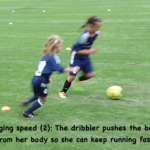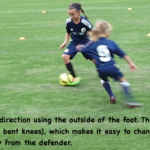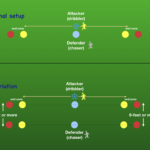
 Do you want to test your dribbling turns, stop and go moves, fakes and tricks against an opponent? The electric fence 1v1 dribbling game is a great way to get started!
Do you want to test your dribbling turns, stop and go moves, fakes and tricks against an opponent? The electric fence 1v1 dribbling game is a great way to get started!
Skills you will develop:
Electric fence helps you develop the ability to use dribbling moves to create space for yourself. You’ll try turns, stop and go moves and fakes, along with changes of speed, to get away from a shadow defender.
Why the name “electric fence?” Because there’s a barrier between the attacker and the defender. The defender can’t cross the barrier to steal the attacker’s ball. You can’t see the barrier, so we call it an electric fence.
Since the defender can’t cross the fence, the attacker gets a chance to develop her dribbling moves and her ability to create space without losing the ball if she makes a mistake. (When you start to rule at electric fence and want a bigger challenge, the snow cones game is a good next step.)
What you’ll need:
- Two players: an attacker (also called the runner or the dribbler), and a defender (also called the chaser or the shadow). You can use anyone as the defender; that person doesn’t need to be a soccer player.
- A soccer ball (two soccer balls if you play the two-ball version).
- Five cones (or socks, tennis balls, cans, pine cones or other markers).
- A level space 10-15 yards wide and 5 yards deep.
Video demos:
There are three different versions of the electric fence game:
- no-ball: learn the rules without using a soccer ball
- one-ball: attacker dribbles a ball; defender chases without a ball
- two-ball: attacker and defender both dribble balls
The videos below show demos of each version of the game. Scroll down past the videos (or use the above links) to see rules and tips for each game. You can move from one video to another by using the directional arrow at the top right of the screen.
No-ball electric fence:
The no-ball game is a good way to get started. You learn the rules and secrets to success without having to focus on ball control.
 Setup an “electric fence” with a cone in the center, and cones or markers to mark small end zones about 5-7 yards away on both sides.
Setup an “electric fence” with a cone in the center, and cones or markers to mark small end zones about 5-7 yards away on both sides.
- A runner (attacker) and a chaser (defender) face each other at the center cone. The row of cones is an “electric fence” between them.
- The runner scores a goal by running into either end zone (left or right side) before the chaser can get there. The keys to success:
- Trick the chaser by pretending to go one way, and then go the other way.
- Bend your knees to get low as you change direction.
- As soon as you trick the chaser, run as fast as you can (“explode”) to the end zone.
- The chaser can’t score, but she can prevent a goal by stepping into the end zone before the runner gets there.
- The runner gets 30-45 seconds to score as many goals as she can. Once you start play, keep playing! You don’t need to restart at the center cone after scoring.
- After you finish a round, rest 30 seconds or so, and then switch roles (runner to chaser, chaser to runner). Which player can score the most goals?
One-ball electric fence:
This is the classic version of the game. It follows the same ideas as the no-ball version, but adds dribbling skills.
Setup an “electric fence” with a cone in the center, and small end zones about 5-7 yards away on both sides.
- An attacker (dribbler) and a defender face each other at the center cone. The row of cones is an “electric fence” between them. The defender can’t reach across the fence to steal the ball or knock it away (otherwise she gets “electrifried”).
- The attacker starts play by dribbling to either side. The defender tries to shadow the attacker. The attacker can score a goal by dribbling into either end zone (left or right side) before the defender can get there. The attacker needs to keep the ball under control and not let it roll out of the end zone. The attacker’s keys to success:
- Trick the defender by doing a dribbling move (a turn, a stop and go, or a fake) to get her off balance. If you’re facing a quick defender, you may need to combine two moves (like a turn with a stop and go, or two turns).
- As soon you trick the defender, take a firm getaway touch — 2-3 steps out from your feet — and explode (accelerate) toward the end zone away from the defender.
- The defender can’t score, but she can prevent a goal by stepping into the end zone before the attacker gets there.
- The attacker gets one minute to score as many goals as she can. Once you start play, keep playing! You don’t need to restart at the center cone after scoring.
- After you finish a round, rest 30 seconds or so, and then switch roles (attacker to defender, defender to attacker). Which player can score the most goals?
If the attacker is having trouble scoring goals, try two-ball electric fence. One-ball electric fence can be hard for the attacker to have success, but two-ball electric fence gives the attacker an advantage.
Two-ball electric fence:
- This follows the same rules as one-ball electric fence, except the defender also has to dribble a ball while trying to shadow the attacker.
- This variation is great for mismatched opponents. Start with the less experienced player as the attacker, and the more experienced player as the defender.
The two-ball game gives the attacker a better chance to score, and makes it more challenging for the defender. Why? Because the defender has to chase the attacker while trying to keep her own ball under control!
